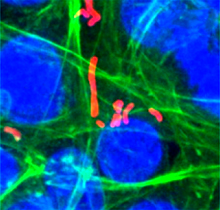Killing Cancer With Radioactive Bacteria
Killing Cancer With Radioactive Bacteria
Live bacteria delivered a lethal radioactive payload to pancreatic cancer cells in mice. With further development, the experimental approach might one day help doctors fight this deadly type of cancer in people.

Listeria (red) inside pancreatic tumor cells 6 hours after infection. Image by the Gravekamp and Dadachova labs, used courtesy of PNAS.
Experts predict more than 45,000 new cases of pancreatic cancer will arise nationwide this year, with over 38,000 deaths from the disease. Cancer therapy is often effective against primary tumors, but not against metastases—cancer cells that spread to other parts of the body. Unfortunately, most diagnoses are made after pancreatic cancer has spread.
Pancreatic tumors force immune cells to tolerate and even support their growth. To take advantage of this property, a research team led by Drs. Ekaterina Dadachova and Claudia Gravekamp at Albert Einstein College of Medicine of Yeshiva University used the bacterium Listeria monocytogenes, which is known for causing foodborne illness. In previous work, the scientists showed that weakenedListeria injected into mice persisted in primary tumors and metastases but were cleared from normal tissues by the immune system within 3 to 5 days. The bacteria might therefore be used to deliver anticancer agents to kill tumor cells.
In their new study, the researchers coupled a radioisotope, 188rhenium, to the bacteria by using Listeria-binding antibodies. The researchers chose rhenium because it delivers a short, strong dose of deadly beta-particles but has a half-life of less than 17 hours. The work was funded by NIH’s National Cancer Institute (NCI) and National Institute on Aging (NIA). Results appeared online on April 22, 2013, in the Proceedings of the National Academy of Sciences.
The researchers first confirmed that the radioactive bacteria could infect and kill tumor cells from a mouse model of aggressive pancreatic cancer. They then developed a protocol to maintain high enough bacterial levels in the mouse body to kill tumor cells without making the mice sick from infection. The protocol involved multiple injections with small doses of the bacteria over the course of 3 weeks.
The scientists found that this treatment reduced the number of metastases by 90% compared to control mice injected with saline. It also reduced primary tumor weight by an average of 64% compared to saline controls.
Metastases had radioactivity levels 4- to 15-fold higher than all organs except the liver and kidneys. Levels in livers and kidneys were comparable to those in metastases. However, the radioactivity didn’t appear to damage or alter the organs’ functions. The normal cells in these tissues may not be as vulnerable to radioactive damage as those in tumors because they don’t divide as quickly. Neither the bacteria nor radioactivity were detected in any normal or tumor tissue a week after the last treatment.
This approach might lead to novel therapies to combat metastases and help prevent pancreatic cancer from recurring. “At this point, we can say that we have a therapy that is very effective for reducing metastasis in mice,” Gravekamp says. “Our goal is to clear 100% of the metastases, because every cancer cell that stays behind can potentially form new tumors.”
By Harrison Wein, Ph.D.
###
* The above story is reprinted from materials provided by National Institutes of Health (NIH)
** The National Institutes of Health (NIH) , a part of the U.S. Department of Health and Human Services, is the nation’s medical research agency—making important discoveries that improve health and save lives. The National Institutes of Health is made up of 27 different components called Institutes and Centers. Each has its own specific research agenda. All but three of these components receive their funding directly from Congress, and administrate their own budgets.



















